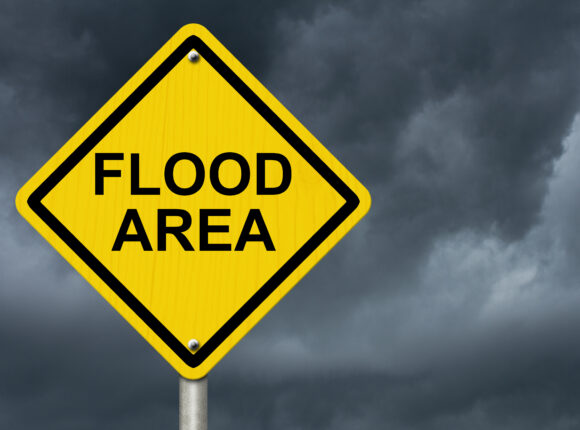A New Jersey law requiring residential and commercial landlords and sellers of real estate to disclose any flood history and potential flood risks to prospective renters and purchasers goes into effect Wednesday, March 20.
Prior to the adoption of the flood risk disclosure law, sellers and landlords were under no obligation to disclose a property’s flood history to potential buyers and tenants or inform them if the property was located in a Federal Emergency Management Agency (FEMA) Flood Hazard Zone Area.
Now, under the measure signed into law by Governor Phil Murphy in July, they must make those disclosures prior to the signing of residential or commercial sales contracts, leases, and lease renewals.
To implement the law, the state has updated the property condition disclosure statement for use by sellers and a notice for landlords to give to prospective renters. The state has also created an internet look-up tool searchable by mailing address that identifies properties in flood hazard areas.
“New Jersey is experiencing more frequent and intense flooding and science tells us that extreme weather is going to continue to worsen for decades to come,” said Jennifer M. Coffey, executive director, Association of New Jersey Environmental Commissions.
The state has warned that an estimated 40,000 New Jersey properties will be at risk of permanent coastal flooding by 2050 because of sea-level rise.
While a number of states have disclosure rules of some sort, the Natural Resources Defense Council (NRDC) rates New Jersey and six other states as having the strongest disclosure laws. The other states are New York, Oklahoma, Texas, South Carolina, Louisiana and Mississippi.
Questions to Answer
The updated disclosure form’s questions include whether a property is located within the FEMA’s Special Flood Hazard Area (100-year floodplain) or Moderate Risk Flood Hazard Area (500-year floodplain), whether the property has experienced flood damage or pooled water due to heavy rainfall or other natural flood event, and if the property is subject to any requirement under federal law to obtain and maintain flood insurance. The model Seller’s Property Condition Disclosure Statement can be found on the Division of Consumer Affairs website.
Also available online is the model rental flood risk notice that can be used by landlords. It contains questions about the flood risk of the property and space for landlords to answer yes, no, or unknown, based upon the landlord’s actual knowledge. The model notice also contains basic information about flood insurance available to renters through FEMA’s National Flood Insurance Program and about the effects of climate change on flood risks.
Exemptions from the renters notice requirements include dwelling units in premises containing not more than two such units; owner-occupied premises of not more than three dwelling units; and hotels, motels, or other guest houses serving transient or seasonal guests (120 days or less).
To further assist landlords and sellers with meeting the disclosure requirements, the Department of Environmental Protection developed the Flood Risk Notification Tool. This online tool enables users to search properties by mailing address to identify whether the property overlaps with the FEMA Special or Moderate Flood Hazard Areas.
“For far too long, countless New Jerseyans have lacked the critical information they not only need, but deserve, to make smart, forward-looking decisions for their properties and families,” said Governor Murphy when signing the measure. “In the aftermath of Tropical Storm Ida – and as flooding events continue to increase in frequency and severity – these requirements will help better prepare New Jersey homeowners and renters for extreme storms.”
In related news, the national real estate site Realtor.com has expanded the environmental risk information it is including in its online listings. The site, which already includes ratings of flood and wildfire risk for listed properties, has added ratings for air quality, severe wind risk and severe heat risk.
Flood Mitigation
The state has had its share of major storms and flood events over the years including three so-called 500-year storm: hurricanes Floyd in 1999, Irene in 2011, and Ida in 2021. The state has several property buyout programs underway in several of the most flood-prone communities including Lambertville and Manville.
Just this past January, 16 counties were placed under flood watch and last week 15 counties were. Communities along the Passaic and Saddle Rivers in particular have been dealing with floodwaters after heavy rainstorms.
The state has begun two of the largest flood control projects to protect two densely populated cities of New Jersey. There is a project in Hoboken, which was inundated by flooding during the 2012 storm, and another in the densely populated Meadowlands region, which also saw catastrophic flooding. The projects will cost nearly $298 million.
Those state projects are in addition to huge flood control efforts being considered by the federal government. They include a $52 billion plan to build movable barriers and gates across bays, rivers and other waterways in New York and New Jersey, and a $16 billion plan to address back-bay flooding in New Jersey by building movable storm gates at inlets and across bays. There is also discussion of elevating 19,000 buildings near waterways in many parts of the state.
Was this article valuable?
Here are more articles you may enjoy.


 Storm Goretti Batters Europe With Violent Winds, Power Cuts
Storm Goretti Batters Europe With Violent Winds, Power Cuts  Billionaire NFL Owner Suing Over Billboards Near His SoFi Stadium
Billionaire NFL Owner Suing Over Billboards Near His SoFi Stadium  California Bill Would Require Insurer Claims Handling Plans, And Double Penalties
California Bill Would Require Insurer Claims Handling Plans, And Double Penalties  Musk’s xAI Faces California AG Probe Over Grok Sexual Images
Musk’s xAI Faces California AG Probe Over Grok Sexual Images 